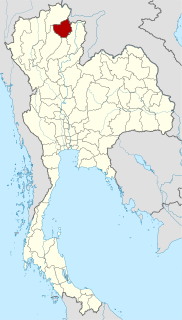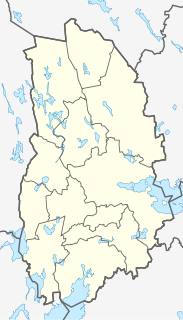
The Mon are an ethnic group native to Myanmar's Mon State, Bago Region, the Irrawaddy Delta and the southern border with Thailand. One of the earliest peoples to reside in Southeast Asia, the Mon were responsible for the spread of Theravada Buddhism in Indochina. The Mon were a major source of influence on the culture of Myanmar. They speak the Mon language, an Austroasiatic language, and share a common origin with the Nyah Kur people of Thailand; they are from the Mon mandala (polity) of Dvaravati.

The Kingdom of Sukhothai was an early kingdom in the area around the city Sukhothai, in north central Thailand. The Kingdom existed from 1238 until 1438. The old capital, now 12 km outside Sukhothai in Tambon Mueang Kao, is in ruins and has been designated as a UNESCO World Heritage Historical Park.

The Lao Kingdom of Lan Xang Hom Khao existed as a unified kingdom from 1354 to 1707.

Setthathirath or Xaysettha is considered one of the great leaders in Lao history. Throughout the 1560s until his death, he successfully defended his kingdom of Lan Xang against military campaigns of Burmese conqueror Bayinnaung, who had already subdued Xieng Mai in 1558 and Ayutthaya in 1564. Setthathirath was a prolific builder and erected many Buddhist monuments including Wat Xieng Thong in Louang Phrabang and the That Luang in Viangchan.
Northern Thai, Lanna, or Kam Mueang is the language of the Northern Thai people of Lanna, Thailand. It is a Southwestern Tai language that is phonotactically closely related to Lao. Northern Thai has approximately six million speakers, most of whom live in the native Northern Thailand, with a smaller community of Lanna speakers in northwestern Laos.

The Northern Thai people or Tai Yuan, self-designation khon mu(e)ang are a Tai ethnic group of eight provinces in northern Thailand, principally in the area of the former kingdom of Lan Na. As a Tai group, they are closely related to Tai Lü and Tai Khün with regards to common culture, language and history as well as to Thailand's dominant Thai ethnic group. There are approximately 6 million Tai Yuan. Most of them live in Northern Thailand, with a small minority 29,442 living across the border in Bokeo Province and Sainyabuli Province of Laos. Their language is called Northern Thai, Lanna, or Kham Mueang.

Chiang Mai sometimes written as "Chiengmai" or "Chiangmai" is the largest city in northern Thailand. It is the capital of Chiang Mai Province and was a former capital of the kingdom of Lan Na (1296–1768), which later became the Kingdom of Chiang Mai, a tributary state of Siam from 1774 to 1899, and finally the seat of princely rulers until 1939. It is 700 km (435 mi) north of Bangkok near the highest mountains in the country. The city sits astride the Ping River, a major tributary of the Chao Phraya River.

Phayao is one of the northern provinces (changwat) of Thailand. Neighboring provinces are Nan, Phrae, Lampang, and Chiang Rai. In the northeast it borders Xaignabouli of Laos.

Mangrai, also known as Mengrai, was the 25th king of Ngoenyang and the first king of Lanna. He established a new city, Chiang Mai, as the capital of the Lanna Kingdom (1296–1558).
Southern Thai, also known as Pak Thai or Dambro, is a Southwestern Tai language spoken in the fourteen provinces of southern Thailand as well as by small communities in the northernmost Malaysian states. It is spoken by roughly five million people, and as a second language by the 1.5 million speakers of Pattani and other ethnic groups such as the local Thai Chinese communities, Negritos, and other tribal groups. Most speakers are also fluent or understand the Central Thai dialects.

Nan is a town in northern Thailand. It is 688 kilometres (428 mi) north of Bangkok. It is in the centre of Nan Province which bears its name, and of which it is the former administrative capital. It covers tambon Nai Wiang and parts of tambon Pha Sing of Mueang Nan District, an area of 7.60 square kilometres (2.93 sq mi) divided into 30 chumchon. In 2010 it had a population of 21,333 spread along the Nan River's right bank. Nan is a small city, primarily devoted to commercial, administrative, educational, and hospital activities. The old heart of the city, where Wat Phumin, the national museum and other tourist attractions are found, is being restored.

The Tai Tham script, Lanna script or Tua Mueang, is used for three living languages: Northern Thai, Tai Lü and Khün. In addition, the Lanna script is used for Lao Tham and other dialect variants in Buddhist palm leaves and notebooks. The script is also known as Tham or Yuan script.
Kingdom of Rattanatingsa or Kingdom of Chiang Mai was the vassal state of the Siamese Rattanakosin Kingdom in the 18th and 19th century before being annexed according to the centralization policies of Chulalongkorn in 1899. The kingdom was a successor of the medieval Lanna kingdom, which had been under Burmese rule for two centuries until it was captured by Siamese forces under Taksin of Thonburi in 1774. It was ruled by the Thipchak Dynasty and came under Thonburi and was later a Bangkokian tributary.

Dara Rasmi, The Princess consort, was a princess of Chiang Mai and Siam and the daughter of King Inthawichayanon of Chiang Mai and Queen Thip Keson of Chiang Mai descended from the Chet Ton Dynasty. She was one of the princess consorts of Chulalongkorn, King Rama V of Siam and gave birth to one daughter by King Chulalongkorn, HRH Princess Vimolnaka Nabisi.

Yun Bayin (1558–1564) is one of the 37 nats in the official pantheon of Burmese nats. He was King Mekuti Sutthiwong or Mae Ku, the captive king of Lanna Kingdom, who died of illness during the reign of King Bayinnaung of Toungoo (1551–1581). He is portrayed sitting with right knee raised, right hand holding a sheathed sword across the shoulder, and left hand on left knee.

Wat Suan Dok, also known as Wat Buppharam is a Buddhist temple (Wat) in Chiang Mai, northern Thailand. It is a Royal Temple of the Third Class. The temple is on Suthep Road, approximately one kilometre west of Suan Dok gate at the west side of the moat.

The Phayao Kingdom was a period in the history of Phayao in Northern Thailand. It began with a revolt against the Chiang Rai rulingship in the northern Thailand.
The Camadevivamsa is a Pali chronicle composed in the early 15th century by the Lanna Buddhist monk Mahathera Bodhiramsi. The chronicle, dated to c. 1410, is a semi-historical recounting of the founding of the Mon Dvaravati kingdom of Hariphunchai (Haripunjaya) in the mid-sixth century by Queen Cāmadevi and her establishment of a lineage destined to rule Haripunchai for the next 500 years. The manuscript ends with King Adittaraja's discovery of a sacred relic of the Buddha in the eleventh century that became central to the Theravada Buddhist culture of Haripunchai and is still enshrined in Wat Phradhatu Haripunjaya in present-day Lamphun, Thailand. In addition to the Camadevivamsa, which is also known in English as The Legend of Queen Cama and The Chamadevivongs, Bodhiramsi also composed, in 1417, the Tamnan Phraphutthasihing, another chronicle which describes the history of the Sihing Buddha, from its creation in Ceylon to its enshrinement in 1411 at Chiang Mai, the capital of Lanna.

Wat Phra Chedi Sao Lang is a Buddhist temple in Lampang, Thailand. The temple is located approximately 1.5 kilometres (0.93 mi) north of Lampang, and is noted for its series of 20 chedi arranged in a courtyard. The chedis' bases are built in the Lan Na style, and whose upper parts are built in the Burmese style. The temple also houses a 15th-century solid gold Buddha image that weighs 1,507 kilograms (3,322 lb).

















